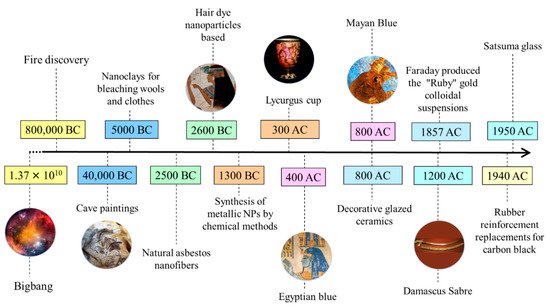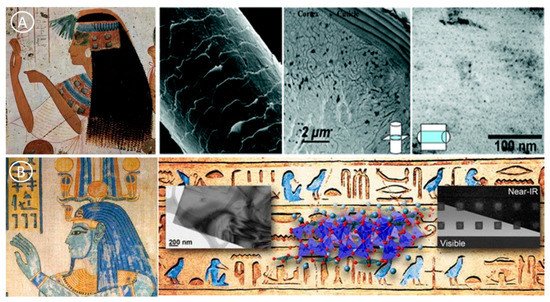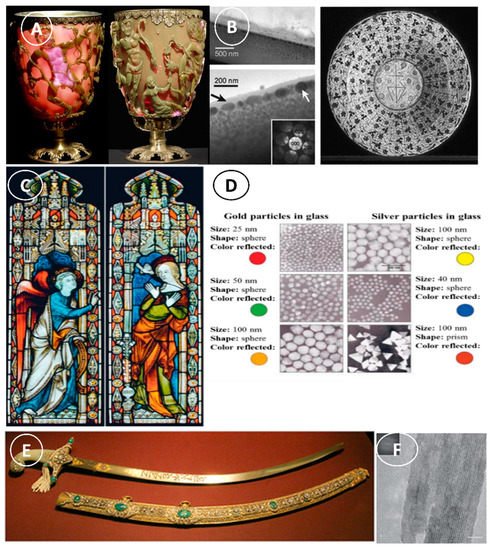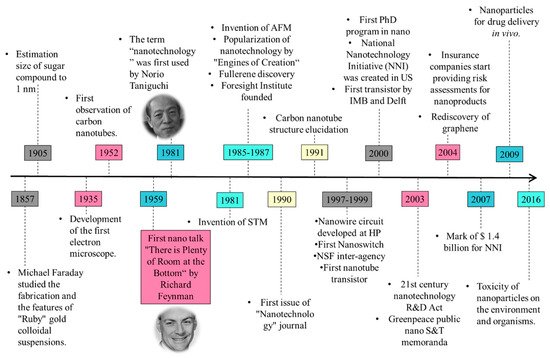You're using an outdated browser. Please upgrade to a modern browser for the best experience.
Please note this is a comparison between Version 2 by Lindsay Dong and Version 3 by Lindsay Dong.
Scientists think that nanoparticles and nanostructured materials originated during the Big Bang process from meteorites leading to the formation of the universe and Earth. Since 1990, the term nanotechnology became very popular due to advances in imaging technologies that paved the way to specific industrial applications.
- nanoparticles
- nanostructures
1. Introduction
Nanotechnology combines distinct domains (engineering, chemistry, physics, biology, and medicine) with the ultimate aim of creating ‘things’ at the scale of atoms. One nanometer (i.e., one billionth of a meter) is the diameter of a hydrogen atom. The term nanotechnology (or ‘“nanotech”) used in recent times describes the manipulation of matter. The manipulation by chemical, molecular, and supramolecular methods fabricates nanoparticles (NPs), nanomaterials, and nanostructured materials. Nanotechnology interests also in studying the specific features observed upon modification (particularly reduction) of the size of the nanoparticles [1]. In particular, tiny nanoparticles with sizes <10 nm exhibit exclusive properties compared with bulk particles. Moreover, size reduction dramatically alters the nanomaterial’s optical, electrical, and magnetic features. For example, 20 nm diameter Au NPs have a localized surface Plasmon resonance at a wavelength of 520 nm in water, which redshifts to 600 nm as the Au NPs diameter increases to 100 nm [1].
Nanomaterials differ in their dimensions, shapes, sizes, compositions, porosity, phases, and uniformity and thus, several classifications have been used to categorize them. To date, many types of nanomaterials have been described and many more will be developed. Nanomaterials can also be classified into naturally occurring, incidental, bioinspired, and engineered nanomaterials in the function of their origin [2]. Naturally occurring nanomaterials form during natural physicochemical processes. Incidental nanomaterials, also known as anthropogenic or waste particles, occur because of man-made industrial processes [3]. Engineered nanomaterials are fabricated in the laboratory/industry to obtain materials with specific features. Bioinspired are engineered nanomaterials the properties of which mimic those of natural nanomaterials or living matter [4]. Engineered and bioinspired nanomaterials are gaining attention among researchers, but they represent only a small part (in terms of mass) relative to the natural nanomaterials’ varieties [5][6][7]. Despite their exclusive properties, few engineered and bioinspired nanomaterials have been approved and used in the industry, due to the need for large-scale production, and risk assessment processes.
2. History and Development of Nanomaterial Research
Forest fire products, volcanic ash, ocean spray, radioactive decay, and weathering processes of metal- or anion-containing rocks are among the natural sources of nanomaterials. It is thought that nanoparticles and nanostructured materials originated from meteorites generated during the Big Bang process that led to the formation of the universe and Earth. Nanodiamonds extracted from meteorites are considered the most abundant type of presolar grain [8]. Naturally occurring nanomaterials have been intimately associated with life development on the Earth, from the first cells to humans. Nanomaterials and their derivatives have been produced and employed by humans since prehistoric times. Due to major advances in nanomaterials characterization techniques [9][10], it is becoming possible to better assess all nanomaterial types and their origins can be studied of nanomaterials in Earth systems and to better frame, their longer-term effects impact on the Earth environment and on human health can be estimated. Figure 1 shows the timeline of nanotechnology developments in various ancient civilizations and distinct epochs (prehistoric, ancient, medieval, modern, and contemporary). The contemporary period in nanomaterials development lasted until 1959, and modern nanotechnology was initiated in the 1960s.
Figure 1. Timeline summarizing ancient civilizations; they produced and used nanomaterials without knowing their nanosized characteristics.
2.1. Prehistoric Nanomaterials
Since prehistoric times, humans have been using fire. The smoke and soot of such fires contained nanoparticles (e.g., fullerenes, graphene, and carbon nanotubes) and other combustion by-products. Our ancestors used these carbon nanomaterials and waxes for cave paintings. Hand stencils in the caves of Sulawesi, Indonesia, are the oldest known examples of artistic expression by humans. The carbon dating results showed that these cave paintings were created in 40,000 BCE using fat, charcoal, and plant pigments [11][12][13]. Similar cave paintings are visible also in the Chauvet-Pont-d’Arc cave, France (the date at 34,000 BCE). Analysis of cave paintings suggests that people of ancient civilization used nanomaterials, such as graphene, without knowing it (Figure 2) [13].


Figure 2. Ancient Paintings in Chauvet-Pont-d’Arc and Lascaux caves containing nanostructures. © MCC/DRAC. Open Access.
2.2. Nanomaterials and Ancient Civilizations
While nanomaterials appear as a new term at the end of the 19th century, nanomaterials have been produced and used already in ancient civilizations. In ancient Egypt, the soot of oil lamps was used to make black pigments of high opacity and stability for writing on papyrus. At that time, Egyptians did not know that soot contains carbon nanomaterials. Clay minerals, nano-platelets about 1 nm in thickness, are among the best examples of natural nanomaterials used in ancient times (5000 BC). Humans manipulated ceramic matrix materials reinforced with natural asbestos nanofibers (50–200 nm in diameters) earlier than 4,500 years ago [14]. For instance, they were used for wool and cloth bleaching in Cyprus [15]. Ancient Egyptians used synthetic chemical processes for producing the fabrication of PdS2 NPs (with a diameter of ~5 nm in diameter), as ingredients for the preparation of hair colorants (Figure 3A) [16]. Sometime around 2575 BC, Egyptians were already producing a synthetic pigment (Egyptian blue, nanosheets of 5 nm in thickness), based on a sintered mixture of nanosized glass and quartz (CaCuSi4O10 and SiO2) (Figure 3B) [17]. Similarly, a blue pigment phase was produced in China in which Ba (Ba Cu Si4O10) replaced the Caused in Egypt. Egyptian blue was massively used for decorative purposes in many countries that were part of the Roman Empire [17].


Figure 3. Nanomaterials produced by humans in ancient civilizations: (A) Egyptians produced PdS2 NPs as a dye for hair [16], © American Chemical Society, 2006; (B) Egyptians produced Egyptian blue (CaCuSi4O10 and SiO2, nanosheets of less than 5 nm in thickness) [17], © American Chemical Society, 2013.

2.3. Nanomaterials in Medieval Times
The common utilization of NPs (particularly metallic NPs) and nanostructures by Romans is one of the most significant illustrations of ancient nanomaterials usage and nanotechnology knowledge in ancient times. One of the most impressive examples of illustrations of Roman glass manufacturing is the Lycurgus cup (Figure 4A), the oldest known dichroic glass that displays two distinct colors when exposed to different light wavelengths. The Lycurgus cup looks green under direct light, and red-purple when lit from the back (Figure 4A) [18]. Transmission electron microscopy analysis showed that the dichroism is caused by the presence of nanoparticles of 50–100 nm in diameter in the glass [19]. Transmission electron microscopy analysis revealed two thin layers of Ag NPs (5–10 nm) in the outer surface and thicker layers (5–20 nm) in the inner part (Figure 4B) [20]. Similarly, in the glass windows of late medieval churches, the bright red and yellow colors are the results of the inclusion of Au and Ag NPs in the glass in its molten state (Figure 4C, D) [21]. Moreover, in the 13th–18th centuries, “Damascus” steel was used to manufacture blades. This steel contained cementite nanowire, and carbon nanotubes (CNT) to give power, toughness, and sharpness (Figure 4E,F) [22]. Noteworthy, nanomaterials could be identified in all these ancient materials after the development of imaging facilities to characterize the nanomaterials morphology.
Figure 4. Examples of some handmade nanomaterials used in medieval times. (A) The Lycurgus cup is brilliant red when light passes through the glass that contains Au-Ag NP alloy (The Trustees of the British Museum/Art Resource, NY). (B) Ag NPs in ancient ceramic plates [23]. © Wiley, 2004 (C) Nanoparticles in medieval church windows [24]. © MDPI, 2000 (D) Transmission electron microscopy (TEM) images of the Au and Ag NPs used in colored window glasses in medieval churches. (E) Saber made of Damascus steel (photograph by Tina Fineberg for The New York Times); (F) TEM image of CNTs in a Damascus Saber after dissolution in hydrochloric acid, showing some cementite nanowires encapsulated by carbon nanotubes (scale bar, 5 nm) [22]. © Nature, 2006.
2.4. Nanomaterials in the Modern Age
The modern age of nanotechnology and the story of this magnificent discovery takes us back to a man named Michael Faraday (Figure 5) who investigated the properties of light and matter in the mid-1850s. In 1857, he studied the fabrication and the features of “Ruby” gold colloidal suspensions and showed that Au NPs can alter the solution color under certain light conditions [25]. Another important and revolutionary contribution to nanotechnology was the development of the scanning tunneling microscope by Gerd Binning and Heinrich Rohrer to acquire high-resolution images of nanomaterials [26][27][28]. In resume, Figure 5 presents the most remarkable events and discoveries that defined modern nanotechnology. In 1996, F. Curl, Harold W. Kroto, and Richard E. Smalley were awarded the Nobel prize for the discovery of fullerenes in 1985. Moreover, in 2010, Andre Geim and Konstantin Novoselov received the Nobel Prize in Physics for the physical properties at room temperature of graphene delaminated from graphite [29][30].In 1952, Radushkevich and Lukyanovich were the first to describe carbon nanotubes [31] by electron microscopy. The lecture entitled “There is plenty of room at the bottom” by Richard. P. Feynman at the American Physical Society yearly meeting on 29 December 1959, opened a whole new field, known as ‘nanotechnology’ [1].


Figure 5. Timeline of nanomaterials discovery in the modern nanotechnology era.
3. Nanomaterial Market Size
Recently, many nanomaterials have been developed dramatically enhanced the features of bulk materials such as strength, conductivity, toughness, lightness, to add new interesting characteristics such as self-healing, self-cleaning, anti-freezing, anti-bacterial, and so forth [32]. The global nanomaterials market size was estimated at USD 8.0 billion in 2020 and is expected to reach USD 9.4 billion in 2021. It also is expected to expand at a compound annual growth rate (CAGR) of 14.1% from 2021 to 2028. In 2012, Logitech marketed an iPad keyboard powered by solar irradiation, using dye-sensitized solar cells. AbraxaneTM sold bound nanoparticles form of paclitaxel bound to human albumin in 2005; FDA approved such nanoparticles for cancer treatment [33]. In 2014, more than 1800 nanotechnology-based consumer products were commercialized in more than 20 countries [34]. Altair Nanotechnologies, EMFUTUR Technologies, Southern Clay Products, Fuso Chemicals, DuPont, Evonik Industries (RAG-Stiftung), Bayer, BASF, and Ahlstrom-Munksjö, are a few of the main players in the global nanomaterials industry. According to Global Industry Analysts, Inc., the nanomaterial market in the United States (US) was US$2.1 billion in 2021, and in China, it should reach US$1.2 billion by 2026 (compound annual growth rate of 11.4% for the studied period). Similarly, in Japan, Canada, and Germany, the compound annual growth rate is estimated at 8.1%, 8.7%, and 9.1%, respectively, for the same period [35][36]. More information can see [37].
References
- Jeevanandam, J.; Barhoum, A.; Chan, Y.S.; Dufresne, A.; Danquah, M.K. Review on nanoparticles and nanostructured materials: History, sources, toxicity and regulations. Beilstein J. Nanotechnol. 2018, 9, 1050–1074.
- Prasad, S.; Kumar, V.; Kirubanandam, S.; Barhoum, A. Engineered nanomaterials: Nanofabrication and surface functionalization. In Emerging Applications of Nanoparticles and Architectural Nanostructures: Current Prospects and Future Trends; Elsevier Inc.: Amsterdam, The Netherlands, 2018; pp. 305–340. ISBN 9780128135167.
- Hammani, S.; Barhoum, A.; Nagarajan, S.; Bechelany, M. Toner waste powder (twp) as a filler for polymer blends (LDPE/HIPS) for enhanced electrical conductivity. Materials 2019, 12, 3062.
- Sudha, P.N.; Sangeetha, K.; Vijayalakshmi, K.; Barhoum, A. Nanomaterials history, classification, unique properties, production and market. In Emerging Applications of Nanoparticles and Architectural Nanostructures: Current Prospects and Future Trends; Elsevier Inc.: Amsterdam, The Netherlands, 2018; pp. 341–384. ISBN 9780128135167.
- Liu, J.L.; Bashir, S. Advanced Nanomaterials and Their Applications in Renewable Energy; Elsevier Science: Amsterdam, The Netherlands, 2015.
- Akpan, E.I.; Shen, X.; Wetzel, B.; Friedrich, K. Design and Synthesis of Polymer Nanocomposites. In Polymer Composites with Functionalized Nanoparticles: Synthesis, Properties, and Applications; Elsevier: Amsterdam, The Netherlands, 2018; pp. 47–83.
- Wang, Z.; Hu, T.; Liang, R.; Wei, M. Application of Zero-Dimensional Nanomaterials in Biosensing. Front. Chem. 2020, 8, 320.
- Dai, Z.R.; Bradley, J.P.; Joswiak, D.J.; Brownlee, D.E.; Hill, H.G.M.; Genge, M.J. Possible in situ formation of meteoritic nanodiamonds in the early Solar System. Nature 2002, 418, 157–159.
- Barhoum, A.; Luisa García-Betancourt, M. Physicochemical characterization of nanomaterials: Size, morphology, optical, magnetic, and electrical properties. In Emerging Applications of Nanoparticles and Architectural Nanostructures: Current Prospects and Future Trends; Elsevier Inc.: Amsterdam, The Netherlands, 2018; pp. 279–304. ISBN 9780128135167.
- Barhoum, A.; García-Betancourt, M.L.; Rahier, H.; Van Assche, G. Physicochemical characterization of nanomaterials: Polymorph, composition, wettability, and thermal stability. In Emerging Applications of Nanoparticles and Architectural Nanostructures: Current Prospects and Future Trends; Elsevier Inc.: Amsterdam, The Netherlands, 2018; pp. 255–278. ISBN 9780128135167.
- Aubert, M.; Brumm, A.; Ramli, M.; Sutikna, T.; Saptomo, E.W.; Hakim, B.; Morwood, M.J.; Van Den Bergh, G.D.; Kinsley, L.; Dosseto, A. Pleistocene cave art from Sulawesi, Indonesia. Nature 2014, 514, 223–227.
- Youssef, A.M.; Moustafa, H.A.; Barhoum, A.; Hakim, A.E.-F.A.A.; Dufresne, A. Evaluation of the Morphological, Electrical and Antibacterial Properties of Polyaniline Nanocomposite Based on Zn/Al-Layered Double Hydroxides. ChemistrySelect 2017, 2.
- Yetisen, A.K.; Coskun, A.F.; England, G.; Cho, S.; Butt, H.; Hurwitz, J.; Kolle, M.; Khademhosseini, A.; Hart, A.J.; Folch, A.; et al. Art on the Nanoscale and beyond. Adv. Mater. 2016, 28, 1724–1742.
- Heiligtag, F.J.; Niederberger, M. The fascinating world of nanoparticle research. Mater. Today 2013, 16, 262–271.
- Mubeen, B.; Ansar, A.N.; Rasool, R.; Ullah, I.; Imam, S.S.; Alshehri, S.; Ghoneim, M.M.; Alzarea, S.I.; Nadeem, M.S.; Kazmi, I. Nanotechnology as a Novel Approach in Combating Microbes Providing an Alternative to Antibiotics. Antibiotics 2021, 10, 1473.
- Walter, P.; Welcomme, E.; Hallégot, P.; Zaluzec, N.J.; Deeb, C.; Castaing, J.; Veyssière, P.; Bréniaux, R.; Lévêque, J.L.; Tsoucaris, G. Early Use of PbS Nanotechnology for an Ancient Hair Dyeing Formula. Nano Lett. 2006, 6, 2215–2219.
- Johnson-Mcdaniel, D.; Barrett, C.A.; Sharafi, A.; Salguero, T.T. Nanoscience of an ancient pigment. J. Am. Chem. Soc. 2013, 135, 1677–1679.
- Reeve, J. The british museum. Cult. Educ. State 2019, 65–94.
- Barber, D.J.; Freestone, I.C. An investigation of the origin of the colour of the lycurgus cup by analytical transmission electron microscopy. Archaeometry 1990, 32, 33–45.
- Nakai, I.; Numako, C.; Hosono, H.; Yamasaki, K. Origin of the red color of satsuma copper-ruby glass as determined by EXAFS and optical absorption spectroscopy. J. Am. Ceram. Soc. 1999, 82, 689–695.
- Bradbury, J. Nature’s Nanotechnologists: Unveiling the Secrets of Diatoms. PLoS Biol. 2004, 2, e306.
- Reibold, M.; Paufler, P.; Levin, A.A.; Kochmann, W.; Pätzke, N.; Meyer, D.C. Carbon nanotubes in an ancient Damascus sabre. Nature 2006, 444, 286.
- Pérez-Arantegui, J.; Molera, J.; Larrea, A.; Pradell, T.; Vendrell-Saz, M.; Borgia, I.; Brunetti, B.G.; Cariati, F.; Fermo, P.; Mellini, M.; et al. Luster Pottery from the Thirteenth Century to the Sixteenth Century: A Nanostructured Thin Metallic Film. J. Am. Ceram. Soc. 2004, 84, 442–446.
- Bayda, S.; Adeel, M.; Tuccinardi, T.; Cordani, M.; Rizzolio, F. The History of Nanoscience and Nanotechnology: From Chemical–Physical Applications to Nanomedicine. Molecules 2019, 25, 112.
- Kheirandish, A.; Sepehri Javan, N.; Mohammadzadeh, H. Modified Drude model for small gold nanoparticles surface plasmon resonance based on the role of classical confinement. Sci. Rep. 2020, 10, 6517.
- Niska, K.; Zielinska, E.; Radomski, M.W.; Inkielewicz-Stepniak, I. Metal nanoparticles in dermatology and cosmetology: Interactions with human skin cells. Chem. Biol. Interact. 2018, 295, 38–51.
- Palmberg, Christopher & Nikulainen, Tuomo, 2006. “Industrial Renewal and Growth through Nanotechnology?—An Overview with Focus on Finland,” Discussion Papers 1020, The Research Institute of the Finnish Economy.
- Stephan, P.; Black, G.C.; Chang, T. The small size of the small scale market: The early-stage labor market for highly skilled nanotechnology workers. Res. Policy 2007, 36, 887–892.
- Geim, A.K.; Novoselov, K.S. The rise of graphene. Nanosci. Technol. 2009, 11–19.
- Ruess, G.; Vogt, F. Höchstlamellarer Kohlenstoff aus Graphitoxyhydroxyd. Mon. Chem. Verwandte Teile And. Wiss. 1948, 78, 222–242.
- Hamid, H.A.; Jenidi, Y.; Thielemans, W.; Somerfield, C.; Gomes, R.L. Predicting the capability of carboxylated cellulose nanowhiskers for the remediation of copper from water using response surface methodology (RSM) and artificial neural network (ANN) models. Ind. Crops Prod. 2016, 93, 108–120.
- Barhoum, A.; Rasouli, R.; Yousefzadeh, M.; Rahier, H.; Bechelany, M. Nanofiber Technologies: History and Development. In Handbook of Nanofibers; Springer International Publishing: Berlin/Heidelberg, Germany, 2019; pp. 3–43.
- Kreuter, J. Nanoparticles—A historical perspective. Int. J. Pharm. 2007, 331, 1–10.
- Vance, M.E.; Kuiken, T.; Vejerano, E.P.; McGinnis, S.P.; Hochella, M.F.; Rejeski, D.; Hull, M.S. Nanotechnology in the real world: Redeveloping the nanomaterial consumer products inventory. Beilstein J. Nanotechnol. 2015, 6, 1769–1780.
- Sargent, J.J.F. The National Nanotechnology Initiative: Overview, Reauthorization, and Appropriations Issues; Congressional Research Service: Boca Raton, FL, USA, 2013.
- Fogelberg, H. Historical Context of the US National Nanotechnology Initiative. In Nano Meets Macro; Jenny Stanford Publishing: Singapore, 2019; pp. 29–53.
- Barhoum, A.; García-Betancourt, M.L.; Jeevanandam, J.; Hussien, E.A.; Mekkawy, S.A.; Mostafa, M.; Omran, M.M.; S. Abdalla, M.; Bechelany, M. Review on Natural, Incidental, Bioinspired, and Engineered Nanomaterials: History, Definitions, Classifications, Synthesis, Properties, Market, Toxicities, Risks, and Regulations. Nanomaterials 2022, 12, 177.
More
